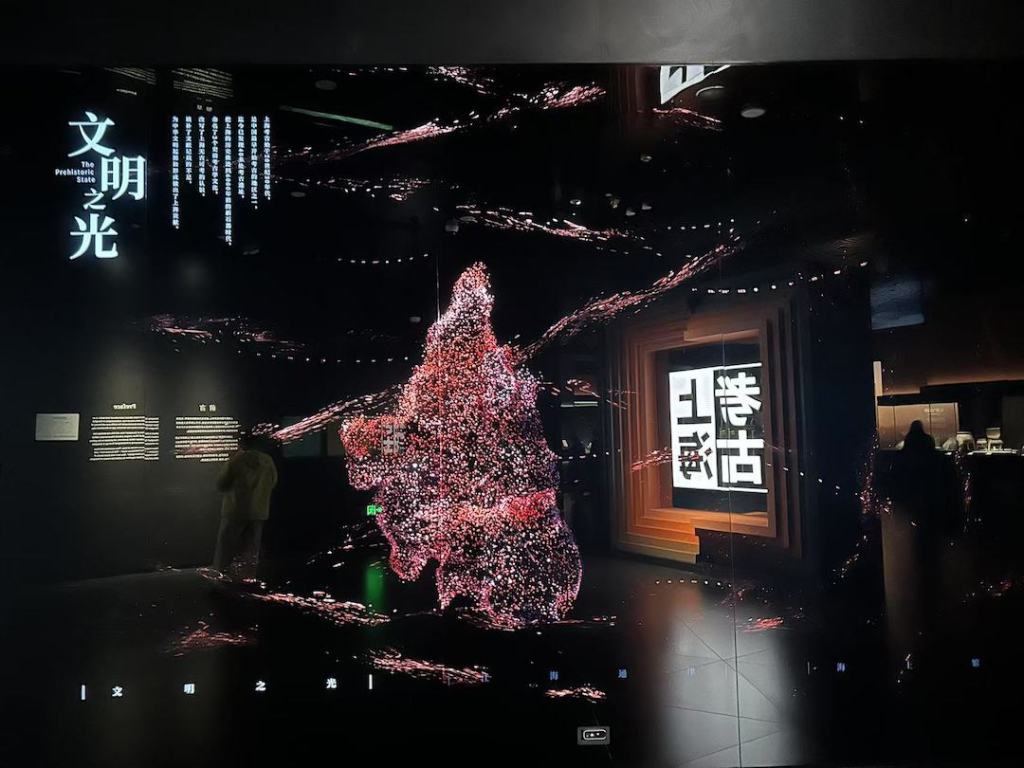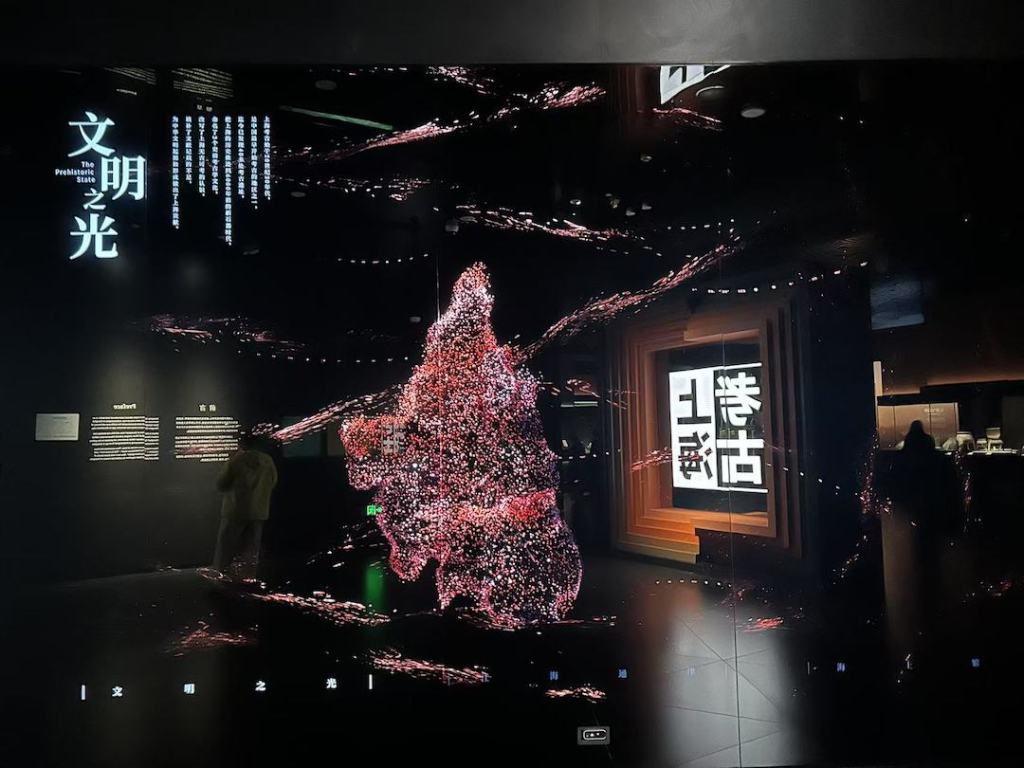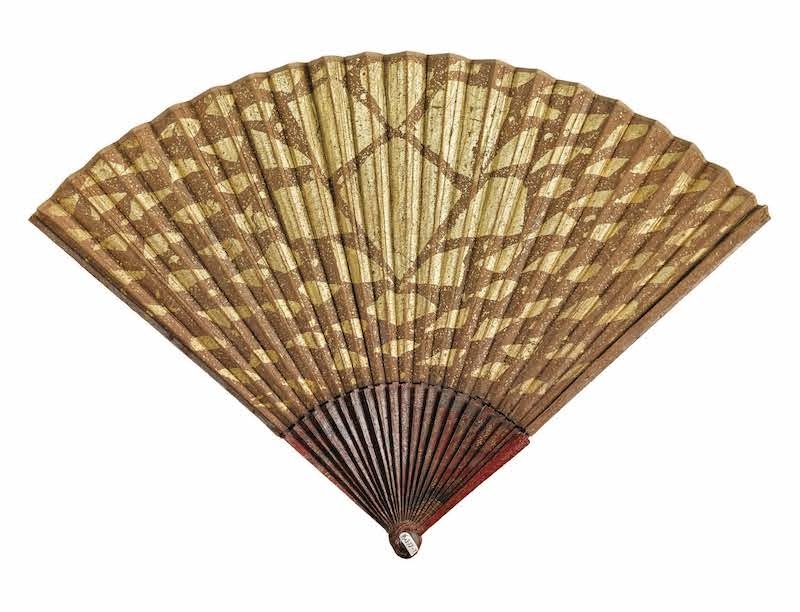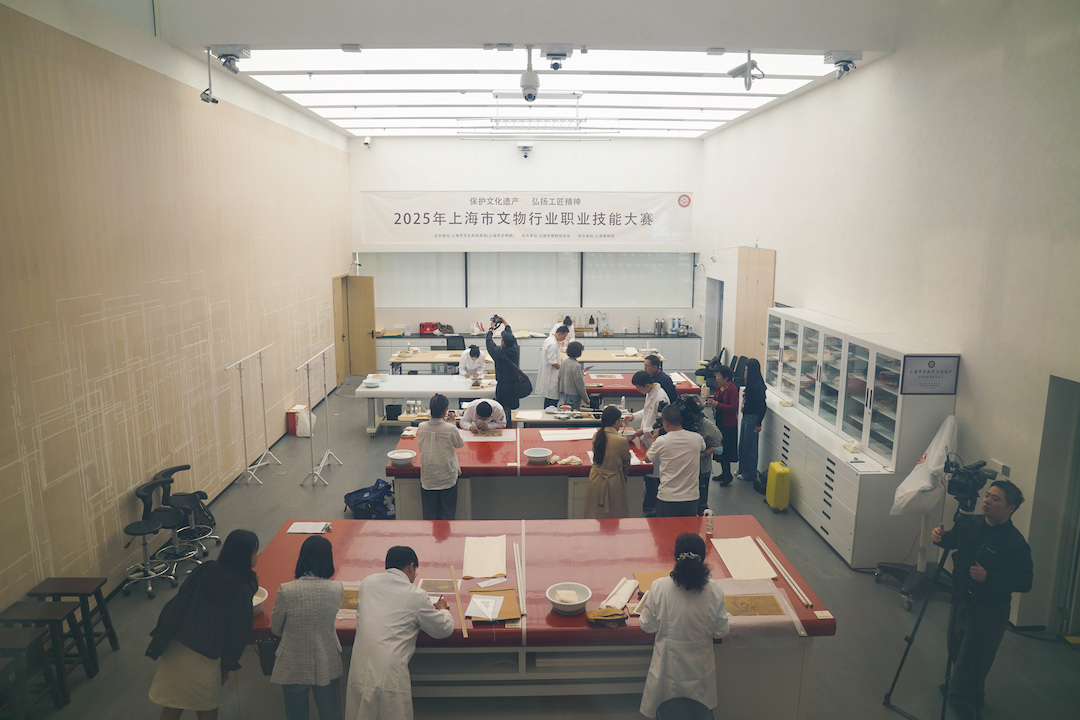

Entering the Restoration Experience Hall on the fourth floor of the East Building of the Shanghai Museum, you will see several transparent floor-to-ceiling glass walls. Through the huge transparent glass, you can see every move of the cultural relic restorers in the restoration display space. The audience can understand the real working status of the cultural relic restorers by "watching". On March 26, a special competition - the Shanghai Cultural Relics Industry Vocational Skills Competition - was held here, and the transparent glass of the Cultural Relic Restoration Experience Hall was crowded with "watching" spectators.
"The way of cleaning the center of the painting is very professional, you can tell at a glance that they are trained in a profession." "It takes only a day and a half to completely restore this broken porcelain plate. The pressure is a bit high, I definitely can't do it." "I saw several contestants brought hair dryers, and it seemed that one also brought an oven. What are they for?" After the theoretical exam in the morning, at 1:00 p.m., the contestants had a practical competition in the Cultural Relics Restoration Experience Hall. Seeing the contestants' focused expressions and skillful movements, the curious audience couldn't help but discuss in a low voice while watching. Among them were many professionals in the field. It can be said that "outsiders watch the excitement, while insiders watch the doorway."
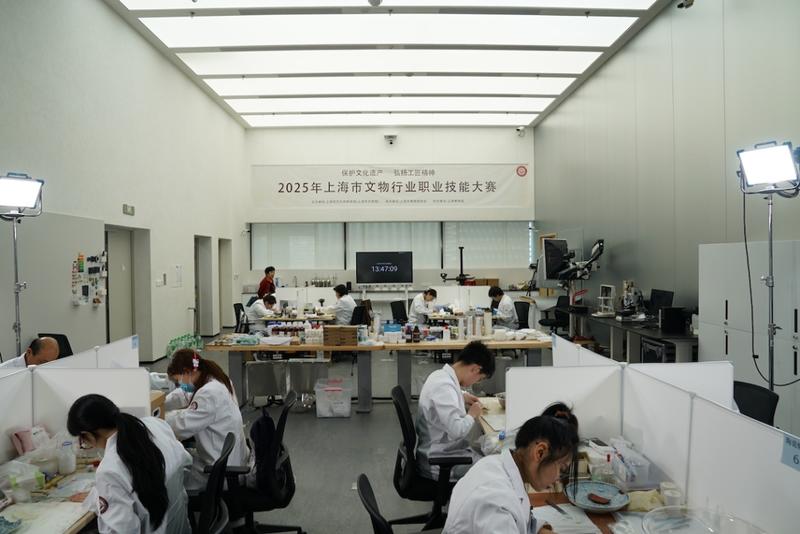
The practical competition site of the 2025 Shanghai Cultural Relics Industry Vocational Skills Competition

The practical competition site of the 2025 Shanghai Cultural Relics Industry Vocational Skills Competition
The "2025 Shanghai Cultural Relics Industry Vocational Skills Competition" opened at the East Hall of the Shanghai Museum on the morning of March 26. It is also the first major event held in Shanghai to showcase cultural relics restoration skills. 22 contestants trained by various cultural and museum units and related colleges in Shanghai participated in the competition. They will show their superb skills in their professional fields through a two-day competition.

Spectators watching the game through the glass
The contestants include professionals from cultural and museum units across the city who are engaged in cultural heritage protection and restoration, as well as teachers and students from colleges and universities offering related majors. Many of them are already the backbone of the field of cultural relics restoration. There are also young students and highly educated returnees who are injecting new vitality into the cultural heritage protection cause.

2025 Shanghai Cultural Relics Industry Vocational Skills Competition Theoretical and Written Examination
The competition has three categories: metal cultural relics restoration, ceramic cultural relics restoration, and paper and calligraphy and painting cultural relics restoration. It adopts a "theory + practice" assessment model, with theoretical written examinations accounting for 20% and practical sessions accounting for 80%. In the competition, contestants will compete on the same stage, compare their skills, and complete the analysis of cultural relics diseases, formulation and implementation of restoration plans within the specified time, comprehensively testing their adaptability and technical accuracy. The winner of this competition will also represent Shanghai in the national cultural relics industry professional skills competition.

Launching Ceremony of the 2025 Shanghai Cultural Relics Industry Vocational Skills Competition
The Shanghai Museum established a cultural relic restoration factory in 1958, and is one of the earliest institutions in China to establish a cultural relic restoration department. After nearly 70 years of inheritance, a cultural relic restoration field and reproduction skills system with orderly circulation, rich connotations and first-class technology has been formed. The newly built cultural relic restoration experience hall in the East Hall of the Shanghai Museum, which is open to the public, also provides an ideal venue for the competition. "For the first time to co-organize the Shanghai Cultural Relics Industry Vocational Skills Competition, we have also made full preparations for this, from setting test questions, selecting restoration works to the provision of restoration materials." Huang He, deputy director of the Shanghai Museum, introduced that the competition mainly tests the professional skills of the contestants, including the combination of traditional skills and modern scientific and technological protection. The jury will score from multiple aspects such as restoration plan, material selection, operation specifications, restoration effect, and written restoration report.
"We also allow contestants to bring their own tools during the competition. Some contestants will invent or modify their own tools in their work practice. Those tools that are easy to use often bring unexpected restoration results. This is also a reflection of the improvement of cultural relics restoration equipment."

Tools and materials prepared by the organizer
At about 1 p.m., the contestants drew lots before the practical competition and officially started the practical competition according to the three groups of metal, ceramics, and calligraphy and painting. The reporter from The Paper saw that the organizers prepared a variety of tools for the contestants on the operating table. "The completeness of the tools is no less than that of national competitions," said Jiang Daoyin, a judge from the ceramic cultural relics restoration project team, a representative inheritor of national intangible cultural heritage, and a professor at the Shanghai Academy of Visual Arts. "Because cultural relics restoration is relatively unpopular, we don't have our own special tools. We all learn from new dental materials and apply them to cultural relics restoration and reproduction techniques, such as plaster, wax sheets, disinfectant, etc. In addition to traditional materials, high-tech tools have also been added with the advancement of technology, and 3D scanning and 3D printing technology have been applied to cultural relics reproduction."

The practical competition site of the 2025 Shanghai Cultural Relics Industry Vocational Skills Competition

The practical competition site of the 2025 Shanghai Cultural Relics Industry Vocational Skills Competition
What are the specific inspection focuses of the practical competition and how are they scored? Wang Ziqiang, a judge from the calligraphy and painting cultural relics restoration project team, a research curator of the China National Silk Museum, and a judge of the National Cultural Relics Industry Vocational Skills Competition, took the calligraphy and painting cultural relics restoration project as an example. The organizer prepared 8 painting cores from the Ming and Qing dynasties for the 8 contestants of the calligraphy and painting cultural relics restoration project team. They are reference cultural relics selected by the cultural relics warehouse, one square foot square, and have different degrees of damage, such as insect infestation, missing, mildew, etc. The contestants first need to formulate a reasonable restoration plan based on the disease of the cultural relics, and then clean the painting core according to the calligraphy and painting restoration process, and then remove the mounting, support, full color, and connect the pen, etc.

The practical competition site of the 2025 Shanghai Cultural Relics Industry Vocational Skills Competition
"After the mounting is removed, we need to find patching paper to patch it up. The patching paper should be close to the original painting, regardless of thickness, color, material, new or old. Full color is one of the most challenging processes for calligraphy and painting restoration skills. Some cultural relics also need to be properly connected, but this competition mainly tests the full color, not the connection." Wang Ziqiang said that the paper dyeing will also be tested at the end to see whether the contestants can dye according to the requirements and whether the dyeing is even and in place. After all the processes are completed, the contestants are also required to clean the operating table, which is also counted as a score.
The Shanghai Museum has five cultural heritage restoration professionals participating in the competition, including veteran experts in the field of metal restoration who have been in the industry for more than 30 years, and young restorers who have been in the industry for less than four years. Zhang Peichen, a research curator at the Shanghai Museum and a representative inheritor of the national intangible cultural heritage of bronze restoration and reproduction skills, told The Paper that "senior restorers have long-term restoration experience and strong practical skills, but may be unfamiliar with theoretical writing or archive production; young restorers are particularly strong in theory during their studies at school, but practical operations are often weak, but the methods and materials they use often break through some traditional cognitions and are inspiring for the development of the industry." Zhang Peichen said, "The gathering of old, middle-aged and young cultural relics restorers will generate new sparks in the process of mutual learning."
"Depending on the difficulty of restoring cultural relics, the restoration time can be as short as a few days or as long as several years. Our competition requires us to complete the restoration of a cultural relic in more than ten hours, and we must also take into account both the observability and the degree of completion. This is quite difficult and is a comprehensive assessment of the contestants' skills."

The practical competition site of the 2025 Shanghai Cultural Relics Industry Vocational Skills Competition
In November last year, the newly revised "Cultural Relics Protection Law of the People's Republic of China" once again emphasized the importance of technology and talent support for cultural relics protection. "I hope that through this competition, we will not only provide everyone with an opportunity to compete and learn from each other, but also create opportunities and motivation for cultivating great craftsmen and highly skilled talents in the field of cultural relics in the city, continuously enhance the social influence and public participation of cultural relics restoration skills, and promote the high-quality development of cultural relics." said Chu Xiaobo, President of the Shanghai Museum Association and Director of the Shanghai Museum.
The competition was hosted by Shanghai Municipal Administration of Culture and Tourism (Shanghai Municipal Administration of Cultural Heritage), organized by Shanghai Museum Association, and co-organized by Shanghai Museum. The competition was held from March 26 to 27, for a total of two days.
